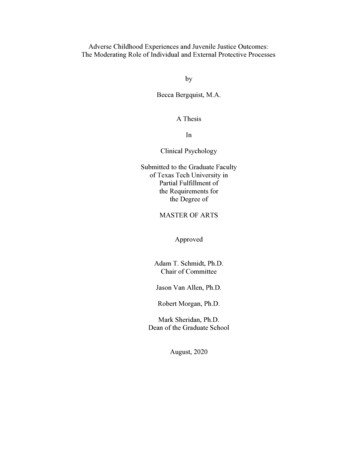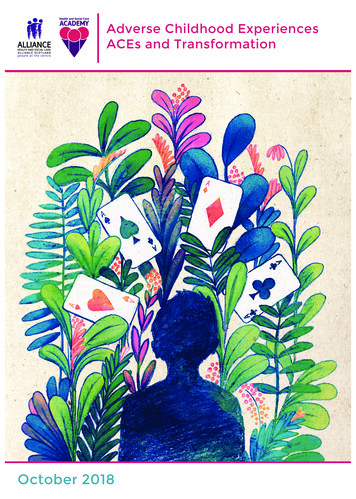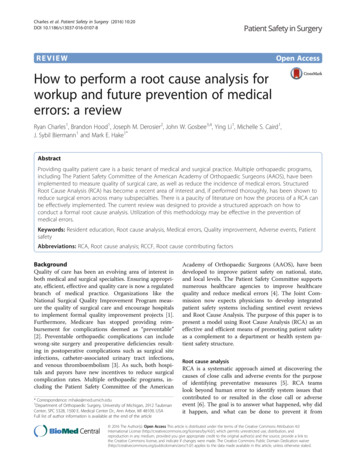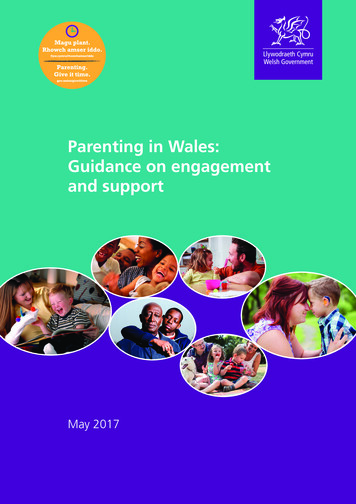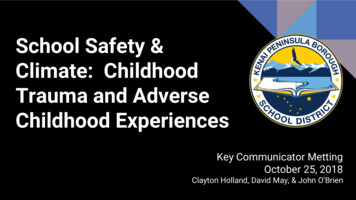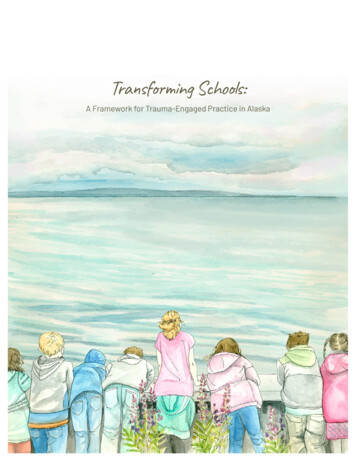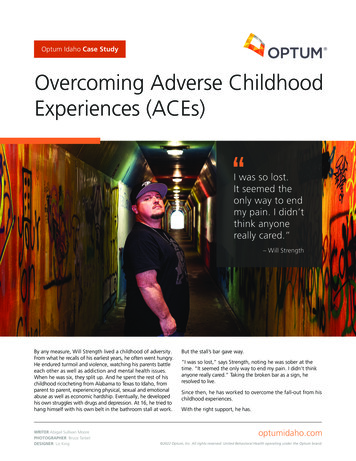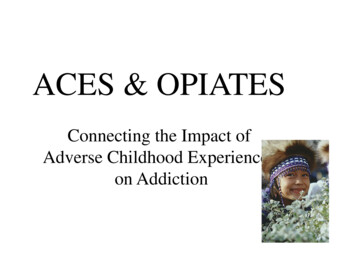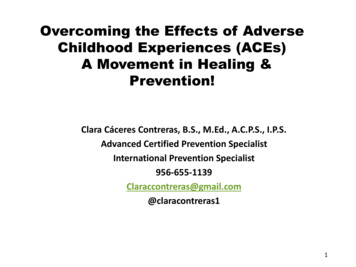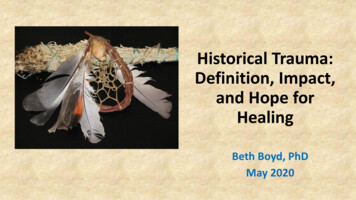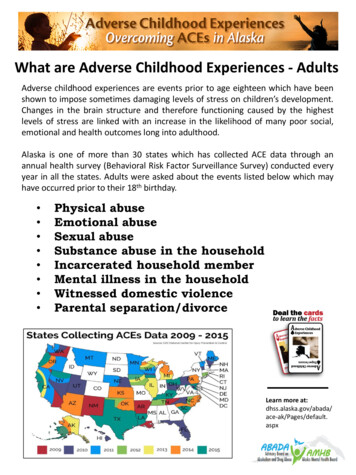
Transcription
What are Adverse Childhood Experiences - AdultsAdverse childhood experiences are events prior to age eighteen which have beenshown to impose sometimes damaging levels of stress on children’s development.Changes in the brain structure and therefore functioning caused by the highestlevels of stress are linked with an increase in the likelihood of many poor social,emotional and health outcomes long into adulthood.Alaska is one of more than 30 states which has collected ACE data through anannual health survey (Behavioral Risk Factor Surveillance Survey) conducted everyyear in all the states. Adults were asked about the events listed below which mayhave occurred prior to their 18th birthday. Physical abuseEmotional abuseSexual abuseSubstance abuse in the householdIncarcerated household memberMental illness in the householdWitnessed domestic violenceParental separation/divorceLearn more at:dhss.alaska.gov/abada/ace-ak/Pages/default.aspx
What are Adverse Childhood Experiences - ChildrenAdverse childhood experiences are events prior to age eighteen which have beenshown to impose sometimes damaging levels of stress on children’s development.Changes in the brain structure and therefore functioning caused by the highestlevels of stress are linked with an increase in the likelihood of many poor social,emotional and health outcomes beginning in childhood and lasting long intoadulthood.In 2011/2012 parents and guardians of more than 94,000 American children wereasked about what a child in their household had experienced so far in their livesthrough the National Survey of Children’s Health. The experiences listed below ofchildren and youth from birth through age 17 were recorded. Included in thissurvey are the results for approximately 1,800 Alaskans. Socioeconomic hardshipDivorce/separation of parentDeath of parentParent served time in jailWitness to domestic violenceVictim of neighborhood violenceLived with someone who was mentally ill or suicidalLived with someone with alcohol/drug problemTreated or judged unfairly due to race/ethnicityLearn more at:dhss.alaska.gov/abada/aceak/Pages/default.aspx
Percentage of Alaskan Adults who Reported Adverse Childhood Experiences*ACEs are Common Childhood StressorsPercentage of Alaskan Children who Experienced Adverse Childhood Experiences***Source: Alaska 2013-215 Behavioral Risk Factor Surveillance System Survey,Division of Public Health, Section of Chronic Disease Prevention**Source: National Survey of Children’s Health 2011/2012
How Does Alaska CompareThere are no national ratesof ACEs for adults but tenstates and D.C represent thelargest sample to which wecan compare Alaska’s resultsSources: 2013-2015 Alaska BRFSS, Section of Chronic Disease and Prevention, Alaska Division of Public Health, Centers forDisease Control and Prevention. Behavioral Risk Factor Surveillance System Survey ACE Module Data, 2010Learn more Source: Child and Adolescent Health Management Initiative (2012). “2011-2012National Survey of Children’s Health (2012), U.S. Department of Health and HumanServices, Health Resources and Services Administration.
ACEs Often Occur in GroupsIf an Alaskan child or youth has one ACE there is a very good chance that they willhave another one too. Below are representative samples of 100 Alaskan childrenand youth by ACE score and samples of those who have experienced one particularACE and their ACE scores.Alaska Children andYouth ACEs in theGeneral PopulationAlaskan Children and YouthACEs for those whoExperienced Low IncomeAlaskan Children and YouthACEs for those whoExperienced WitnessingDomestic ViolenceSource: Child and Adolescent Health Management Initiative (2012). “2011-2012National Survey of Children’s Health (2012), U.S. Department of Health and HumanServices, Health Resources and Services Administration.
Most ACEs Occur - Early in ChildhoodIt is estimated that Alaskan 17year olds, had on average, 1.3ACEs as they were set to enteradulthood. The age at which halfof that ACE load was present wasage three.This has deep significance whenconsidering when and how tointervene and prevent ACEs.Source: Child and Adolescent Health ManagementInitiative (2012). “2011-2012 National Survey ofChildren’s Health (2012), U.S. Department of Healthand Human Services, Health Resources and ServicesAdministration. AMHB/ABADA analysisACEs are ExpensiveIt is estimated that 40.6% of AlaskanAdults receiving Medicaid, do so, as aresult of ACEs. That represents nearly 350,000,000 in annual costs.Learn more Source: Economic Costs of Adverse Childhood Experiences inAlaska, Alaska Mental Health Board and Advisory Board onAlcoholism and Drug Abuse
What Can be Done About ACES?Increase Awareness: In the last dozen years many Alaskans havelearned about ACEs. Hundreds of presentations have been donearound the state. Still, the majority of Alaskans have very little or nounderstanding of the profound social and financial cost ACEs cause.Many groups in Alaska are continuing to spread the word. Every weeknew champions for this work are taking it upon themselves to educatethemselves and others about childhood trauma.Treat Those Who Experienced ACEs: Alaska is fortunate to have theAlaska Child Trauma Center housed at Anchorage Community MentalHealth, Inc. This world class center generously shares its expertiseand partners with others around the state who work closely withadults, children and families who are struggling with trauma. It isimportant that we have a well qualified workforce which is trained inthe latest methods of Trauma Informed Care and accessible toAlaskans. At present the demand outpaces the supply. The Division ofBehavioral Health has been working to close that gap.Continue to Monitor Important Data: Alaska is becoming smarter in itsuse of the wealth of data available to its policy makers. ACE data isimportant but so are child abuse and neglect statistics, school readinessreports and dozens of other key measures being captured. Policymakers need to improve their use of this information and data analystneed to improve everyone’s access to quality information. The Divisionof Public Health’s AK-IBIS link is making great strides toward makingdata available to all.
What Can be Done About ACES?Prevent ACEs: Prevention of ACEs is essential to avoid costlyinterventions after the fact. Support for young families includingpregnant women has been shown to be very cost effective. ACEs are amultigenerational problem so treatment and awareness are long-termprevention models too.Trauma Informed: The predominance of ACEs in Alaskans’ lives and theday to day impact those experiences bring into the places where we livework, and play make being trauma informed essential. Whether it be inthe workplace or schoolhouse being trauma informed pays.Self-Regulation: Research shows that even if someone has experiencedtrauma, if they have the ability to stay calm and focused when facing achallenge, follow through with plans, and remain curious about theworld - these skills are protective when combating the impactsassociated with toxic levels of stress in childhood. These abilities arefostered through supportive relationships and are key to overcomingACEs.Learn more at:dhss.alaska.gov/abada/ace-ak/Pages/default.aspx
Adverse childhood experiences are events prior to age eighteen which have been . emotional and health outcomes long into adulthood. Alaska is one of more than 30 states which has collected ACE data through an . important but so are child abuse and neglect statistics, school readiness reports and dozens of other key measures being captured. .
